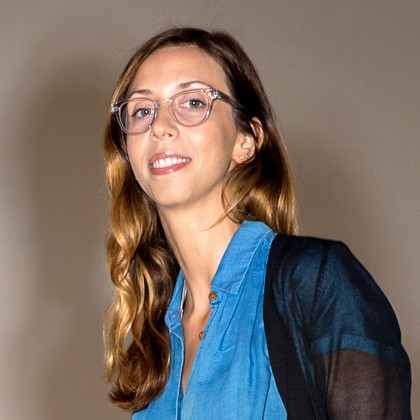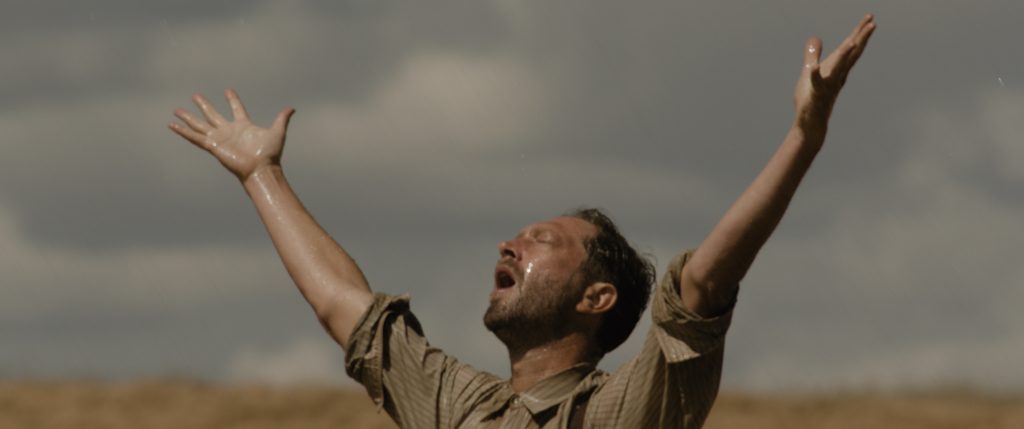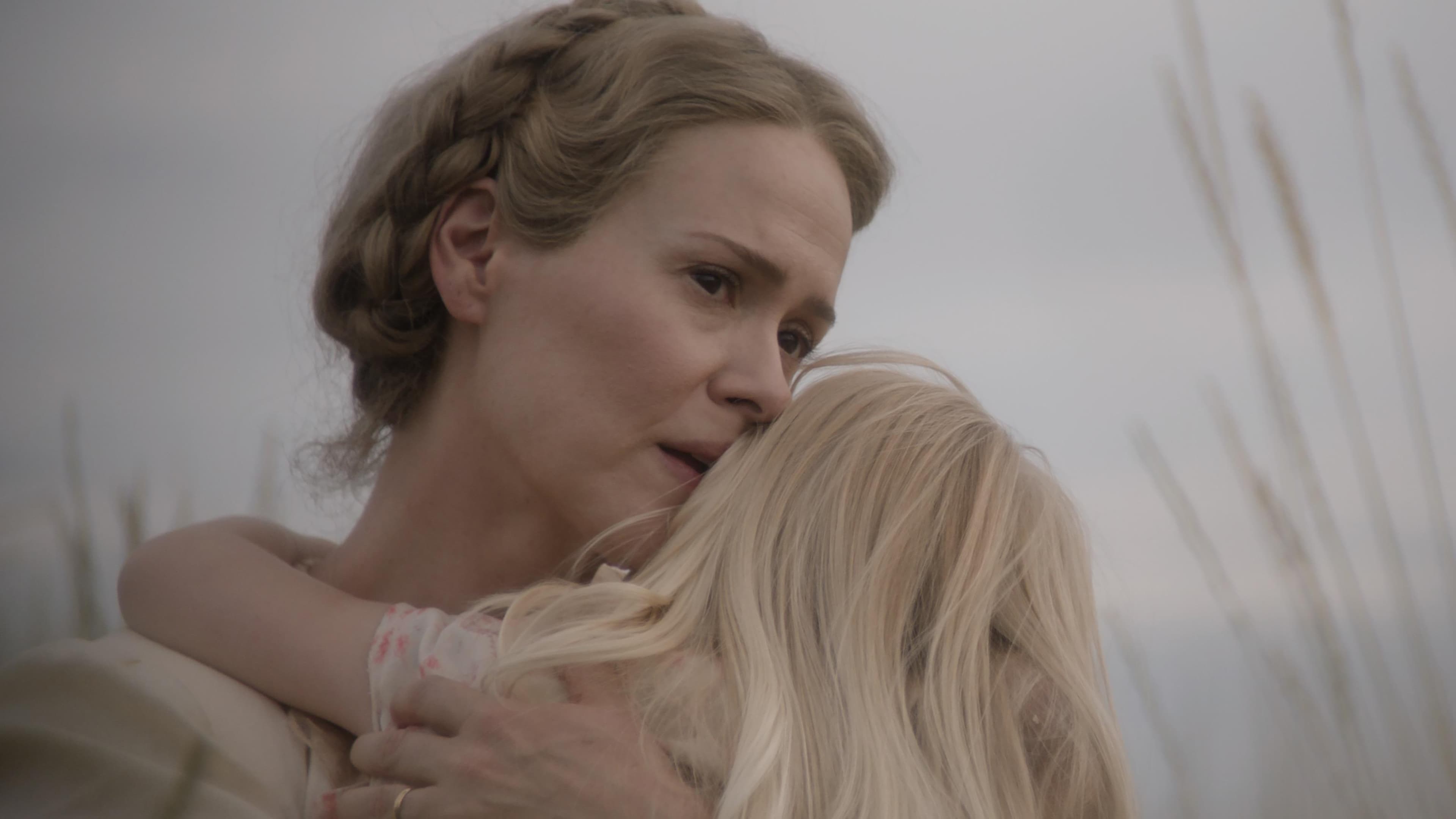When writer Karrie Crouse (Westworld) watched Ken Burns’ 2012 documentary series The Dust Bowl depicting the 1930s drought in North America’s prairie farm land, she was inspired to write a psychological thriller set in this dismal landscape and time period. Where better to delve into a story about a motherly love so fierce that it becomes more dangerous than a world where the dust-packed air can seep through the walls and suffocate you in your sleep?
In Hold Your Breath, Margaret Bellum (played by American Horror Story’s Sarah Paulson) has the stressful task of taking care of her two daughters while her husband is away trying to earn a living to send back to them. Obsessed with their protection from the terrifying dust storms and still reeling from the death of another child, Margaret believes that there is a sinister presence in the air threatening her children… a sense that becomes even more paranoid with the arrival of the mysterious Wallace Grady (Ebon Moss-Bachrach, The Bear) on their doorstep.
Creative Screenwriting spoke with Karrie Krouse about writing this story and the film that marked the joint directorial debut for her and longtime writing partner Will Joines.
Tell me about Burns’ documentary series and the inspiration to set your story in the Dust Bowl
I watched Ken’s series and it brought to mind a lot of literature about that time period, such as The Grapes of Wrath. But it was also the images from that documentary… these towering walls of dust that blotted out the sun. The idea that they had this kind of insidious quality where the dust could sneak its way in through the cracks and it was everywhere.

Karrie Crouse
It started to feel like it was touching on some psychological thriller horror elements. It’s not the way that I’ve ever seen that time period portrayed. There’s also something really fascinating about the fact that the disaster was human made – we went in and over-cultivated and the land turned against us. Just thinking about today’s world and our climate got me really interested in this setting.
It feels timely, especially with the use of masks, but I understand you wrote this before the pandemic happened. What was it like to experience that after you’d created this story and did you revisit the script during that time?
I did get comments from people who had read it before the pandemic and after, and a couple of folks asked if I added more masks! But I think people were just picking up on it in a different way.
But even though all of those elements were in place, it solidified some of the visuals. I remember peeking outside when we were in the initial stages of the pandemic and seeing a mom struggle to get a mask on her kid… and it just felt like life imitating art. This one little gesture brought to mind the idea of “what does it feel like to be so desperate to protect your child, but also be suffocating them at the same time?”
It was an invisible enemy that we were dealing with, particularly early in the pandemic. We were still unclear on exactly how the spread was working. Even though I wrote the story before the pandemic, I think the residue of living through it made its way onto the film.
Tell me about Margaret and the journey her character goes through over the course of the story.
I didn’t start writing until I felt like I had a very strong, gut-level connection with her. I wanted to take a really empathetic view of her journey – even though she’s a complex character and she takes a dark turn, I really identify with what puts her in that position.
For me, a film like The Shining, where the house overtakes the main character and makes him a monster was really interesting to think about. Could you do that to a character with a feeling that we’ve all gone through? What I tapped into was that desperate urge to protect your loved ones. That vulnerable feeling of knowing what it’s like to lose someone, knowing that you don’t have control and yet being driven to try and protect the people you love.
It was important to me that even if she’s misguided at certain moments of the film, the information she has along with the experiences she’s undergone will make you always believe that she is actually trying to keep her family together.
What does Wallace’s character signify?
This is a strange inspiration, but I thought of Rasputin when it came to Wallace. Rasputin ingratiated himself with the royal family with promises of healing the children’s hemophilia. I thought, “If there’s anyone that Margaret can trust, it’s someone who can make himself her savior.” Someone who could appear to be vulnerable, but a man of great power who could actually protect her family. He was a turning point because he is a bit of a relief. He represents hope and promise for her that someone can help her and can help protect her children. When that curdles and he becomes a threat, melding into the Grey Man in her mind, it becomes her against the world at that point.

Wallace (Ebon Moss-Bachrach) Photo Courtesy of Searchlight Pictures
What did Sarah bring to the character of Margaret?
I remember learning in theater class that the most powerful moment is before two characters touch… someone trying to hold control over something inside them. It was really important to us that we weren’t just telling a story of someone coming unraveled, but that we were telling a story of someone who is desperate to protect and hold back her anxiety.
That tension is really there, someone losing a battle against their own anxiety. She just has that complexity within her – I don’t even know how to describe it, but you can honestly point a camera at her and see a battle in her eyes. And you can see it modularly: sometimes it’s a little more trauma, sometimes it’s a little more anxiety… it’s all there in her.
What are some of the themes you explore in this story?
Motherhood was a big part of it. It was really interesting to think about images that could darken and mutate… ones that start out tender but, by the end, can be suffocating. I remember having the idea that the family needed ropes that tied them to the house in a dust storm, and that there could be an almost “umbilical” quality to them. Especially as she draws them in and is sealing them up in the house. But then I read that they actually did have to do that. So that was a good part of the history of the film.
In terms of the horror, for me, I find it a little easier to disconnect if a story is purely supernatural. If it’s just a haunted house, for instance. It was really interesting for me to explore what happens when the monster is in your loved one. I think anyone who’s had someone they love deal with mental illness or addiction can see that the person they love is still in there. You can still see their eyes, but there is something overtaking them and you’re dealt this impossible dilemma. Can you ever let go? You really can’t run and hide. So I played with that idea of the possession of a loved one, whether it be through illness or something else.
There are a few intertwining genres in Hold Your Breath. How would you describe it?
For me, all along it was psychological thriller and horror. I think that as the movie was edited, it moved a little bit more towards the horror genre. But it was the psychological elements that I’m most interested in.
Tell me about your collaboration with Will and what it was like moving from writing partners to directing partners with this being your directorial debut.
We met very early on in film school, in quite a nerdy way – we saw each other’s short films and loved them, and we’ve been working together ever since. We really built our taste together and learned how to make things together. So even when I’m writing, I’m often thinking about the images and the settings that we would want to photograph.
It’s funny, we’re married and it surprises everybody that we can make it through a film. But I don’t think it behooves a filmmaker to not have someone questioning them. I think sometimes you can get into a bad zone as filmmakers gain acclaim and people start telling you you’re brilliant. We have these built-in checks and balances. Sometimes I think having to push for an idea helps you articulate your vision in a sharper way.
So for us, it’s a process that starts early. When I’m done with the script, we start lining it up with our vision, but if we ever have moments of divergence, usually it leads to a more interesting idea.

